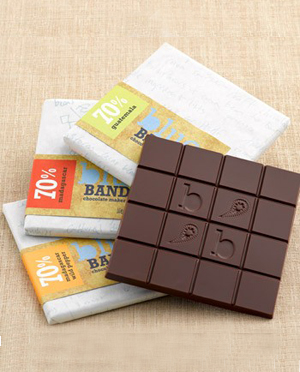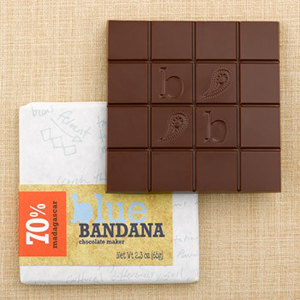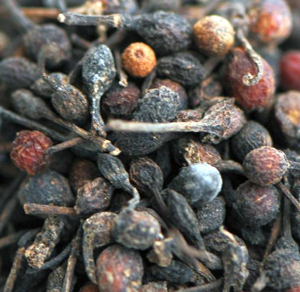 |
 |
| |
Three new artisan chocolate bars made with organic ingredients, and certified kosher. All photography courtesy Lake Champlain Chocolates. |
| WHAT IT IS: Artisan chocolate bars. |
| WHY IT’S DIFFERENT: They’re made with very fine organic chocolate and other organic ingredients, and certified kosher. |
WHY WE LOVE IT: If you’re going to indulge in hot chocolate, this ranks among the best. |
| WHERE TO BUY IT: LakeChamplainChocolate.com. |
|

The 70% Madagascar Wild Pepper Bar, above, is the only bar we know made with voatsiperifery, a wild peppercorn that grows only in Madagascar.
|
|
Blue Bandana Artisan Chocolate Bars
We always like to profile fine chocolate before the Easter holiday. You can check out all of our favorite gourmet chocolates from past years. This year, we’re going simple, with the new line of Blue Bandana artisan chocolate bars from family-owned Lake Champlain Chocolates, made by third-generation chocolatier Eric Lampman.
Handsome bars have debuted in three varieties from two cacao origins:
- 70% Guatemala Dark Chocolate Bar
- 70% Madagascar Dark Chocolate Bar
- 70% Madagascar Wild Pepper Dark
Chocolate Bar
Here’s an explanation of “origin chocolate”—all the beans are from a specific region (i.e., origin).
Organic Ingredients
While not certified organic*, Blue Bandana ingredients are organic: organic cocoa beans, organic cocoa butter and organic cane sugar. The bars are also vegan, although they are made on the same equipment as milk chocolate and may contain traces of milk protein.
The 3.5-ounce bars are $7.00 apiece, and are easily scored so that a small amount can be broken off each day.
The bars are certified kosher by Star-K.
What Makes Blue Bandana Different?
In today’s seemingly vast world of artisan chocolate bars, there are plenty of delicious options. Some, like Michel Cluizel, focus on the craft of bean-to-bar chocolate making to distinguish them. Others, like Vosges, stretch the imagination with unique and often confounding flavor combinations (although these days, ginger, wasabi and black sesame seed-flavored chocolate seems almost conventional).
Like fine art, the flavor of fine chocolate is in the eye—or on the palate—or the beholder. The Blue Bandana chocolate bars stopped me cold in both the level of craft and the originality of the single origin cacao flavors. Most wonderful was how delicious and enjoyable they were to eat. And isn’t that what’s most important?
Bean To Bar
Chocolatier Eric Lampman grew up learning chocolate-making from his father and grandfather, and Blue Bandana is his first foray into making his own products. The name comes from the handkerchief that he would tie around his mouth and nose when the air grew thick with dust from the shelling and separating of cacao beans.
From dusty Madagascar cacao farm to bustling Vermont workshop, Eric was a highly involved part of the production process, helping to hand sort, roast, winnow and grind the carefully selected beans to ensure that the finished product would be something truly special.
(Continue below)
|
| |
|
|
And that it is. The first bar to emerge from Blue Bandana is made with 70% Madagascar cacao beans, as well as a wild peppercorn called voatsiperifery, known to grow only in Madagascar. So right off the bat, you are trying something you can’t try anywhere else: Nobody else out there is making chocolate with an ultra-rare varietal of peppercorn that grows on only one island in the world.
Beyond its uniqueness in ingredients, its flavor profile is truly one that I have never experienced before. It was so enjoyable and different I found it capturing my full attention as I sat there chewing and tasting, trying to place all the different flavor notes that emerged from the cacao and the peppercorn. There is a definite floral overtone when you first bite into the chocolate, one that works more like an aroma in your mouth than as a flavor on your tongue or taste buds, which was something different and very cool; but as the flavor of the wild pepper grows, you get a sense of mustiness, even wood and piney notes. Then comes the intense fruitiness, like berries and tart citrus, balanced by the bitter and earthy notes from the cacao. The peppery flavor you recognize from more common varietals of pepper is there, but without the spice that typically accompanies it.
|
|

Voatsiperifery, the wild pepper of Madagascar. Photo courtesy MadaInfo.de. |
The best part of the experience is that the notes and flavors from the pepper and the cacao play back and forth against one another, neither dominating nor diminishing. It is a truly harmonious balance of flavor: you almost can’t tell where one ends and the other begins. I must say, as I sat there, truly enjoying every bite of this exceptional chocolate, I fully understood the time and care that Eric put into carefully developing the flavor profile of his flagship bar.
I like to think that the harmony also comes in part from the fact that the peppercorn and the cacao grew just miles apart from one another on the sunny island of Madagascar. The two couldn’t bear to be apart, even if it meant they had to be turned into chocolate to stay together. It seems Blue Bandana has discovered a love affair for the ages.
— Johnny Gnall
Do you have friends who would enjoy THE NIBBLE?
Click here to send them an invitation to sign up for their own copy. |
© Copyright 2004-
2025
Lifestyle Direct, Inc. All rights reserved. All information contained herein is subject to change at any time without notice. All details must be directly confirmed with manufacturers, service establishments and other third parties. The material in this webzine may not be reproduced, distributed, transmitted, cached, or otherwise used, except with the prior written permission of Lifestyle Direct, Inc. |
|

|
 |